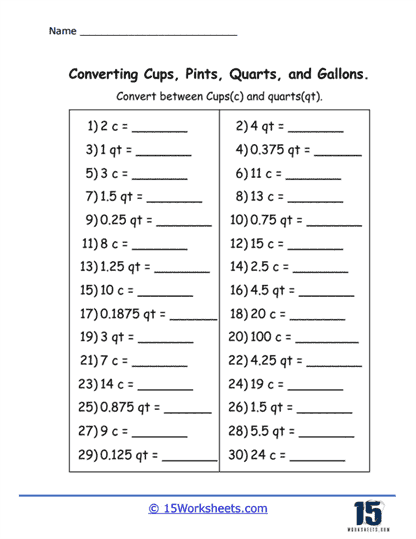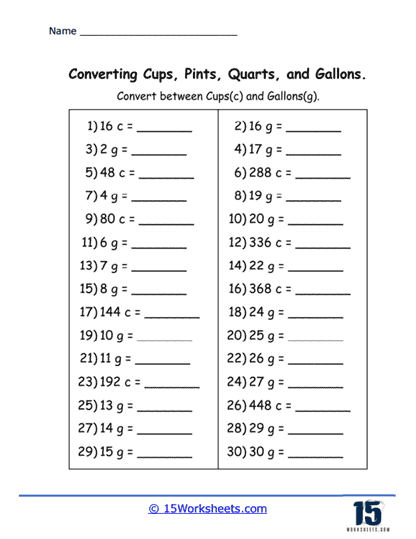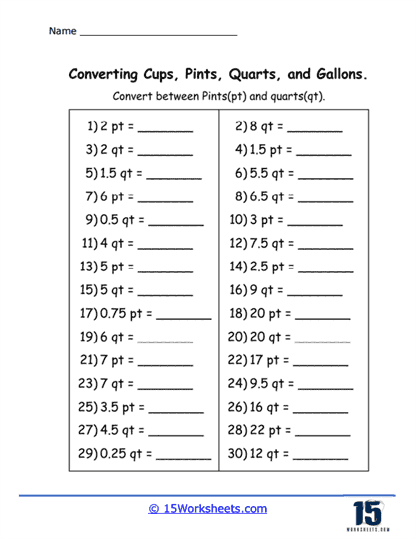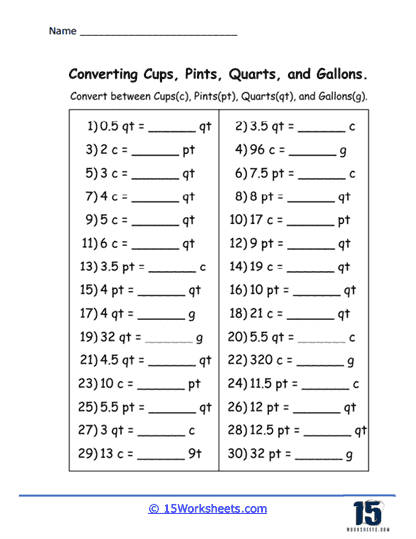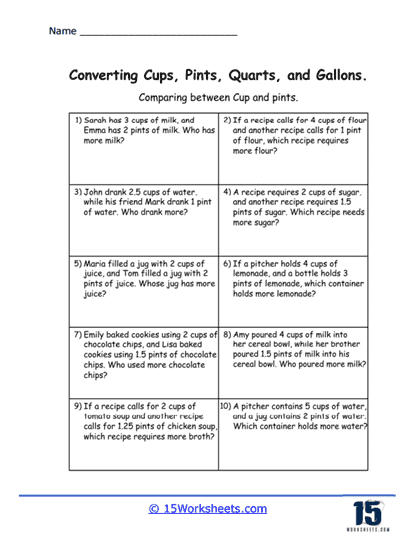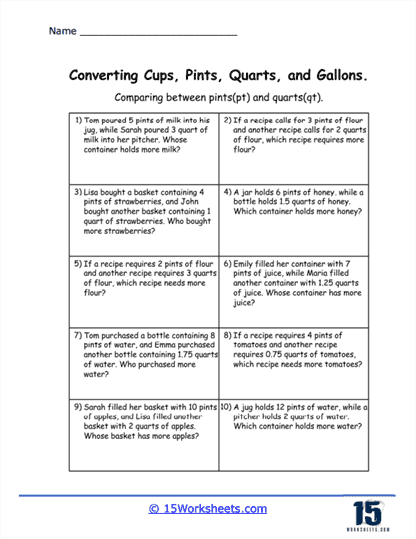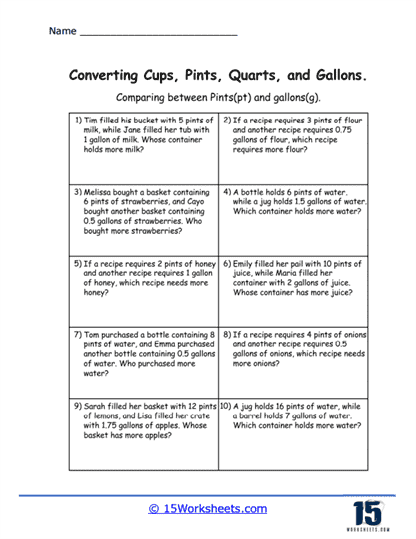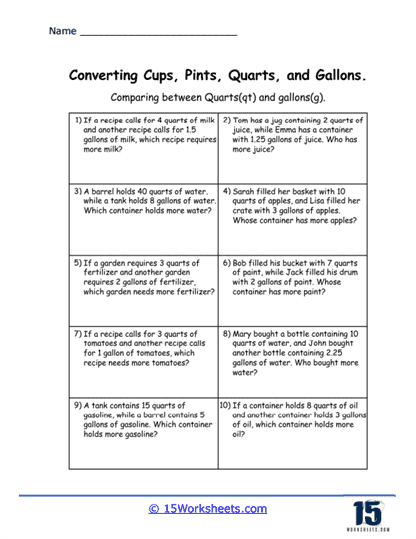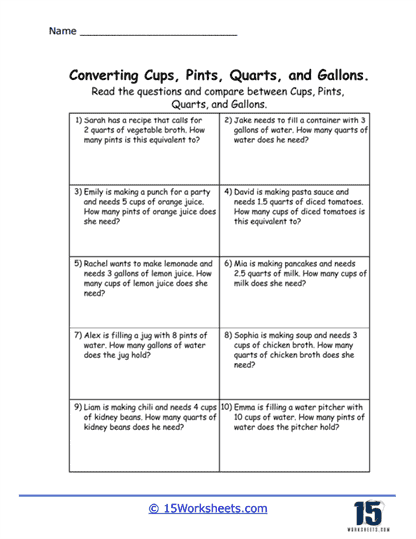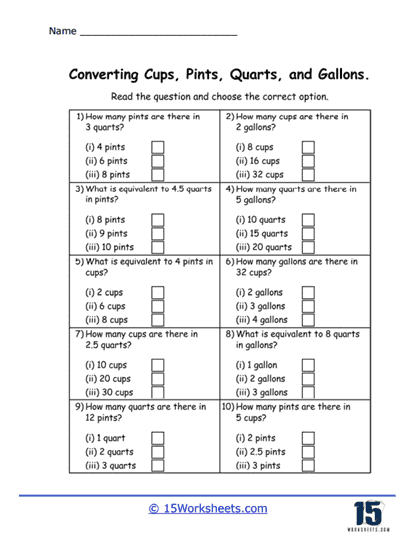Cups, Pints, Quarts, and Gallons Worksheets
About These 15 Worksheets
These worksheets are used to help students learn about the U.S. customary units of liquid capacity. These units form a critical aspect of everyday measurements in the United States, applicable in various scenarios from cooking and baking to fuel purchases and beyond. The worksheets are designed to facilitate understanding of how these units relate to each other, how to convert between them, and how to apply them in practical, real-world situations. By engaging with these worksheets, students develop a foundational skill set that aids them in performing various tasks that require measurement of liquids.
Understanding the Units
Before diving into the types of exercises found on these worksheets, it’s essential to clarify the units involved:
Cup – A standard unit of volume used primarily in cooking to measure liquids and bulk foods.
Pint – Equals two cups. Pints are commonly used in the United States for measuring beverages and smaller quantities of liquids.
Quart – Equals two pints or four cups. Quarts are often used for measuring larger volumes of liquids, such as milk or oil.
Gallon – Equals four quarts, eight pints, or sixteen cups. Gallons are commonly used for measuring substantial quantities like fuel and large containers of liquids.
Types of Exercises
Conversion
Conversion exercises are a staple on these worksheets. They challenge students to convert measurements between cups, pints, quarts, and gallons. These tasks might ask students to determine how many cups are in three gallons or convert five quarts to pints. These exercises strengthen students’ understanding of the relationships between the different units and improve their ability to switch between units fluidly, a necessary skill in both academic and everyday contexts.
Real-World Word Problems
Word problems place students in real-life scenarios where they must apply their knowledge of liquid measurements. For example, a problem might describe a recipe that requires several pints of milk, and students must decide how many gallons or cups are needed. Another common scenario could involve determining the total volume of drinks needed for a party, requiring conversions and additions of various measurements. These problems enhance problem-solving skills and show the practical application of measurement units.
Estimation Exercises
Estimation exercises ask students to estimate the volume of common items or containers without measuring them directly. For instance, they might estimate how many cups of water a particular bowl can hold or guess the number of pints that fill a large cooking pot. These exercises develop a practical sense of volume and prepare students for situations where precise measurements are not possible.
Matching and Sorting Activities
These activities may involve matching quantities with the correct unit or sorting a series of measurements in ascending or descending order. Such exercises reinforce the conceptual understanding of volume and the relative sizes of units, crucial for developing a quick and intuitive grasp of liquid volumes.
In fill-in-the-blank exercises, students complete statements related to volume measurements. These might include sentences where students must insert the appropriate unit of measurement or complete a conversion calculation. This format tests and reinforces students’ knowledge in a direct and engaging way.
Multiple-choice questions test a variety of skills, from identifying the correct conversion between units to choosing the appropriate measuring tool for a given task. These questions are valuable for assessing students’ understanding and decision-making skills under predefined options, providing a quick and efficient method for teachers to gauge student comprehension.
Practical Measurement Tasks
Some worksheets provide practical tasks that involve measuring real items. Students may use measuring cups or other tools to measure out specific amounts of water or another liquid and then record their findings. This hands-on approach helps students understand the tangible aspects of volume measurements. Graphical tasks might ask students to represent data visually using bar graphs or pie charts based on volume measurements. For example, students could graph the amount of each type of beverage consumed at a school event, using different units of measure for each beverage type.
When Are These Units Used In The Real World?
The measurement units of cups, pints, quarts, and gallons play a significant role in various aspects of daily life in the United States. These units are part of the U.S. customary system of measurements and are primarily used for measuring volume, especially in cooking, retail, and automotive industries, among others. Understanding where and how these units are applied in the real world provides insight into their practical importance.
In Cooking and Baking
These liquid measures are extensively used in cooking and baking, which is perhaps the most familiar setting for these units. Recipes commonly list ingredients in cups and tablespoons, which are convenient for measuring both liquid and dry ingredients. The cup is particularly favored in American kitchens due to its convenience for measuring volume during cooking. For example, a recipe might call for one cup of milk, two cups of flour, and a quarter cup of oil. Cooks often use pints and quarts for larger quantities of liquids. For instance, soups and broths are typically measured in quarts, while pints might be used for servings of ice cream or beverages. Gallons are used for even larger quantities, useful in recipes for large gatherings where, for example, punch or lemonade might be made in gallon amounts.
In Beverage Sales
Pints, quarts, and gallons are commonly used in the beverage industry. For instance, milk is often sold in gallons and quarts, while alcoholic beverages such as beer might be sold by the pint in bars and restaurants. This differentiation in unit usage allows for standardization across different types of beverages and container sizes, making it easier for consumers to understand and compare volumes. Gallons are also a standard measure for larger quantities of beverages that are typically consumed in greater volumes, such as soft drinks and water.
In Automotive Applications
In the automotive industry, gallons are particularly important for measuring the capacity of fuel tanks and the fuel efficiency of vehicles (miles per gallon, or mpg). Understanding how many miles a vehicle can travel per gallon of gasoline is crucial for consumers making decisions about car purchases based on fuel efficiency. This usage underscores the gallon’s role in everyday automotive-related activities, from budgeting for fuel costs to considering the environmental impact of driving habits.
In Gardening and Agriculture
Gallons and quarts are also used in gardening and agriculture, especially when measuring liquids for pesticides, fertilizers, or water for irrigation. The gallon is particularly useful for larger-scale applications where substantial quantities of liquids are required, providing a measure that is both practical and scalable. This helps ensure that plants receive adequate water without wastage and that chemicals are applied in safe, effective quantities.
In Retail and Commerce
In retail settings, liquid products such as cleaning supplies, laundry detergents, and beverages are often sold in pints, quarts, and gallons. These units provide a consistent and familiar measure for consumers to compare quantities and prices effectively. For example, when purchasing laundry detergent, a consumer may choose between a quart-sized bottle and a gallon-sized one, typically assessing which size offers better value for money.
In Healthcare
Less commonly, these units can appear in healthcare settings, particularly in historical contexts or in specific reference to dietary intake recommendations. For instance, dietary guidelines might recommend certain quantities of water intake in cups per day. While more precise measurements have shifted towards metric units like liters and milliliters in medical settings, the familiarity of cups and gallons can still be useful for communicating with patients about their fluid consumption.
Understanding the use of cups, pints, quarts, and gallons in these varied real-world contexts reveals how these units facilitate everyday activities and commerce. They allow for standardization and ease of understanding across different sectors, making them indispensable in American society. Whether in the kitchen, at the gas station, or in the supermarket, these units play a critical role in measuring and communicating volume efficiently.


